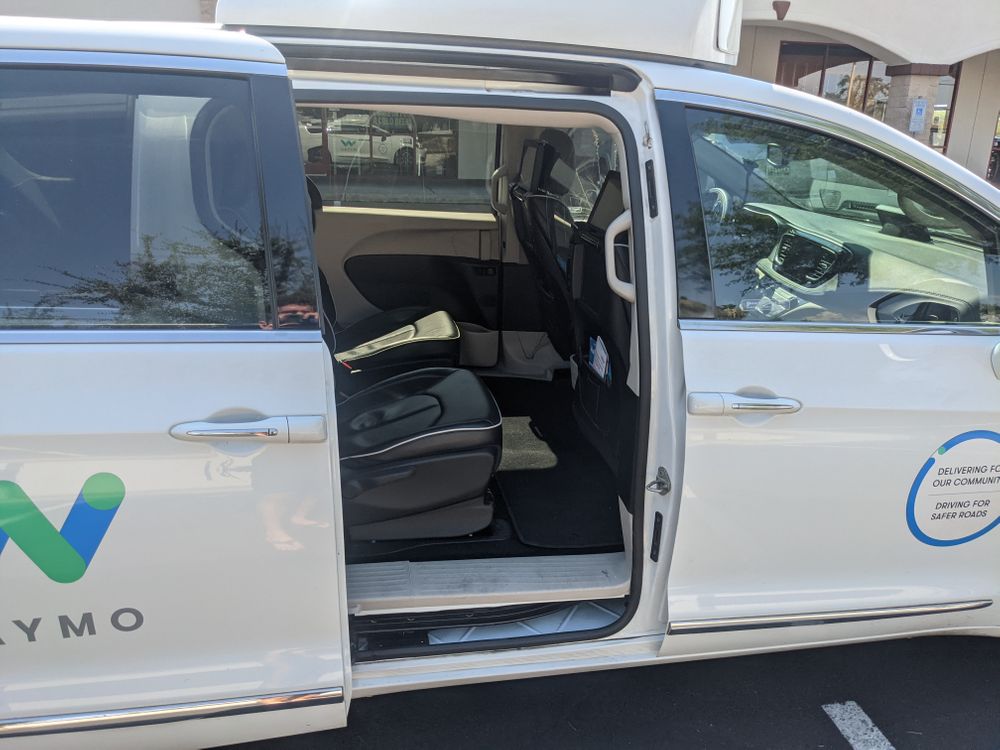|
Good morning. In late June, we sent Ryan to Arizona for a few days so he could get up close and personal with Waymo’s fully driverless ride-hailing service. We’ve published a few pieces from the trip already, and today we’re sharing the final installment.
Read on for the short version, and be sure to click out for the full story on how locals feel about the driverless cars roaming their roads.
In today’s edition:
 A trip to Chandler, AZ A trip to Chandler, AZ
 Large language models Large language models
 Chip shortage update Chip shortage update
—Ryan Duffy, Hayden Field, Dan McCarthy
|
|
|
Ryan Duffy
|
Chandler, Arizona, is a city of just over 250,000 that’s located southeast of Phoenix. Like most of Arizona, it's hot, dry, and lined with cacti and palm trees.
But unlike most of Arizona—or virtually anywhere else in the world—Chandler residents share the road with fully driverless robotaxis, courtesy of Waymo. As Stacy, a Chandler resident, told Emerging Tech Brew, “Waymos are like rabbits in my neighborhood.”
And although residents living in or near the service area may be used to seeing Waymo’s glossy-white, sensor-laden Chrysler Pacificas roving around, the chances they’ve ridden in one are much, much lower.
- In a recent trip to Chandler, of the roughly two dozen locals in the service area we spoke with, every person was familiar with Waymo, but none had ridden in one.
-
The four Arizona cities where Waymo is operational have a combined population of 1.2+ million. Waymo app downloads are an order of magnitude lower than that figure, at ~110,000.
- Waymo says it provides hundreds of rides a week, the majority of which, we presume, are repeat customers.
Back up...self-driving cars?
Since October 2020, the Alphabet subsidiary has been running its driverless ride-hail service, Waymo One, in a 50-square-mile service area that encompasses parts of Chandler, Tempe, Mesa, and Gilbert. Anyone with a smartphone, credit card, and GPS coordinates in the service area can hail a completely driverless ride of their own.
AVs still face a healthy dose of skepticism and mistrust from the general public: A March 2021 Morning Brew-Harris Poll survey found that just 48% of US adults would be comfortable in the passenger seat of an AV. And for their part, regular drivers in Phoenix show a tendency to keep the technology at arm’s length.
“What happens if there is a glitch—is there a backup system?” Antwoin, an Uber driver who lives in Phoenix, asked us. “That’s what I worry about. What if a satellite goes down and the car just goes crazy?”
- Last October, Waymo published a safety report covering 6.1+ million miles of automated driving in Phoenix (and 65,000 driverless miles) from 2019 to Q3 ’20.
- Of the dataset’s 47 “contact events,” 18 happened IRL. 29 were simulated, with Waymo’s software playing out counterfactual scenarios of how its Driver would have acted had a human operator not taken over manual control.
Big picture: Waymo still faces plenty of technical and financial challenges before it can scale a driverless fleet beyond Phoenix. But even if it can clear those hurdles, the early feedback from AZ suggests there is a massive human challenge to overcome as well.
Click here to read the full story.—RD
|
|
|
Francis Scialabba
|
Google wants your search queries to look less like a Jeopardy! answer and more like a chat with your friend—filled with the kind of slang and shorthand only a human would understand.
To get there, the tech giant is enlisting a powerful AI tool you all might remember: a large language model, specifically one called MUM (multitask unified model).
- Large language models, which are trained on datasets as large as one trillion words, help computers process and produce human-like language.
But, but, but: The tech has drawn criticism from parts of the AI community. In the past year, Google fired both co-leads of its AI ethics team after a dispute over their research on the dangers of large language models.
-
One of experts’ top concerns? Models trained via internet data will naturally learn biases—then can easily replicate those patterns and multiply the resulting harms.
Case study
Google hasn’t yet announced a timeline for when it’ll incorporate MUM into live search, but it’s already experimenting with one-off projects.
Then vs. now: In 2020, Google team members spent hundreds of hours compiling the different ways people could refer to Covid in order to accurately route pandemic queries. This year, they wanted to do the same thing for queries about the Covid vaccine—so they used MUM to “generate over 800 names for 17 different vaccines in 50 different languages” within seconds, Pandu Nayak, Google’s VP of search, told Popular Science.
Big picture: Google announced MUM at its developer conference in May alongside other language model initiatives, and now it seems to be doubling down on how important the tech is to its future business model. More sophisticated searches and answers will likely lead to more valuable targeted ads, which could mean big changes for the ad pricing model, reports the FT.—HF
|
|
SPONSORED BY MYSTERY ADVERTISER
|
|
Understanding what customers think of your product should be easy livin’—like eating a scoop of gelato the size of your head as you bask in the summer sunshine.
But conducting research about your users isn’t always so sweet, when you need insights from customers in real time but interviews and surveys take weeks or even months. Or even worse—when you don’t have the expertise or bandwidth to meet with users and share ideas because it’s time-consuming and downright tedious.
Point is: You need to build products your customers love, but to build them you need help from your customers 24/7.
Now for some sunny, sweet-like-gelato good news. There’s a way you can start building better products for your consumers without having to sneak customer calls into your lunch break and do a bunch of data grunt work.
Be the first to find out how with a new product launching soon.
|
|
|
Francis Scialabba
|
As Neal over at the daily newsletter wrote last week, the chip shortage was supposed to start easing up in the second half of 2021.
But it’s not: Susquehanna Financial Group found that the average time it takes for a semiconductor order to be delivered—i.e., lead time—increased to 20.2 weeks in July. That’s up from 19.3 weeks in June, and up from 12.6 weeks a year ago.
- As Bloomberg notes, the lead times grew most for the chips that go into cars, home electronics, and industrial machinery.
- Wait times actually fell for power management chips, which underpin small battery powered devices like smartphones.
In case you need help visualizing the real-world impact, Toyota—which was heralded for its ability to withstand the chip crisis just a few months ago—announced it’d slash auto production in Japan by 40% next month due to...you guessed it. That translates to somewhere between 60,000 and 90,000 fewer vehicles.
- Last week, GM, Ford, Stellantis, and VW said they’d likely cut production due to the ongoing shortage, too.
Looking ahead: The semiconductor shortage has been a defining story of this year, and now some companies expect it to spill over into 2022.—DM
|
|
|
|
Stat: The price of lithium ion batteries, which are used to power everything from mobile phones to electric vehicles, has fallen by 97% since 1991.
Quote: “We had the intuition that if we have an AI system that tells us how to combine ingredients—and what ingredients to combine—we could maybe find a match to the animal alternatives.”—Karim Pichara, cofounder and CTO of NotCo, to Emerging Tech Brew
Read: Marketers are turning to AI-based tools to generate copy for their websites and social media profiles.
The wallet, reimagined: Bakkt® is the digital wallet of the future, helping you to combine and spend participating loyalty and rewards points, trade bitcoin, and manage gift cards all in one place. Unlock hidden digital value with Bakkt today.*
*This is sponsored advertising content
|
|
|
|
Those are some spicy conversion numbers. Here’s a dirty little B2B secret: Only 15% to 30% of demo requests actually show up to meetings. That’s why industry leaders like Spotify use Chili Piper’s Concierge solution to double their conversions and fuel their sales pipeline. Instantly convert inbound leads into qualified meetings. Learn more about Chili Piper here.
|
|
-
General Motors expanded the recall of its Chevy Bolt EV to include every single model. The cause? Battery fires. The (expected) cost? $1.8 billion.
-
PayPal now allows UK customers to buy, sell, and hold cryptocurrency.
-
Virgin Orbit, which carries small satellites into orbit, plans to SPAC.
-
China passed a sweeping new data privacy law amid its broader reevaluation of its tech industry.
|
|
THREE THINGS WE’RE WATCHING
|
|
Wednesday: Snowflake, a data warehousing company, releases its earnings. Back in September, the company made waves as the biggest software IPO ever.
Also Wednesday: President Biden will meet with an undisclosed group of business leaders about strategies for bolstering US cybersecurity.
All week: Google is dismantling its Health division and dispersing units throughout the company. The division’s chief, David Feinberg, will leave the company Sept. 1, Insider reports.
|
|
|
Almost exactly 17 years ago, on August 19, 2004, Google IPOd. Nowadays, it’s the third-most valuable company in the world with a market cap close to $2 trillion, it’s facing multiple antitrust inquiries, and it has a hand in two stories in today’s newsletter. They grow up so fast.
|
|
|
Catch up on the top Emerging Tech Brew stories from the past few editions:
|
|
|









